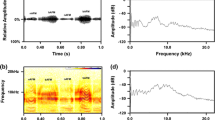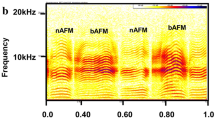Abstract
In a stressful situation, greater short-nosed fruit bats (Cynopterus sphinx) emit audible vocalization either to warn or to inform conspecifics. We examined the effect of distress calls on bats emitting the call as well as the bats receiving the distress signal through analysis of the hypothalamic-pituitary-adrenal axis and catacholaminargic systems. We measured the levels of neurotransmitters [serotonin (5-HT), dopamine (DA), norepinephrine (NE)] and stress hormones [(adrenocorticotropic hormone (ACTH) and corticosterone (CORT)]. Our results showed that distress call emission elevated the level of ACTH and CORT, as well as 5-HT, DA and NE in the amygdala, for both the call emitting bat and the responding bat. Subsequently, we observed increased activity of glucocorticoid receptor and its steroid receptor co-activator (SRC-1). An expression of SRC-1 was up-regulated in the distress call emitter only, whereas it was at a similar level in both the call responder and silent bats. These findings suggest that bats emitting distress calls and also bats responding to such calls have similar neurotransmitter expression patterns, and may react similarly in response to stress.





Similar content being viewed by others
Abbreviations
- 5-HT:
-
5-Hydroxytryptamine (serotonin)
- ACTH:
-
Adrenocorticotropic hormone
- CORT:
-
Corticosterone
- CRF:
-
Corticotrophin-releasing factor
- DA:
-
Dopamine
- GR:
-
Glucocorticoid receptor
- NE:
-
Norepinephrine
- RT-PCR:
-
Reverse transcriptase-polymerase chain reaction
- SRC-1:
-
Steroid receptor co-activator
References
Adell A, Garcia-Marquez C, Armario A, Gelpi E (1988) Chronic stress increase serotonin and noradrenaline in rat brain and sensitizes their responses to a further acute stress. J Neurochem 50:1678–1681
Balasingh J, Koilraj, Kunz TH (1995) Tent construction by the short-nosed fruit bat Cynopterus sphinx (Chiroptera: Pteropodidae) in southern India. Ethology 100:210-229
Bale TL, Lee Kuo-Fen, Vale WW (2002) The role of corticotrophin-releasing factor receptors in stress and anxiety. Integr Comp Biol 42:552–555
Barlow KE, Jones G (1997) Differences in song flight calls and social calls between two phonic types of the vespertilionid bat Pipistrellus pipistrellus. J Zool (Lond) 241:315–324
Behr O, von Helversen O (2004) Bat serenades: complex courtship songs of the sac-winged bat (Saccopteryx bilineata). Behav Ecol Sociobiol 56:106–115
Belz EE, Kennell JS, Czambell RK, Rubin RT, Rhodes ME (2003) Environmental enrichment lowers stress-responsive hormones in single housed male and female rats. Pharmacol Biochem Behav 76:481–486
Bhat HR, Kunz TH (1995) Altered flower/fruit clusters of the kitul palm used as roosts by the short-nosed fruit bat, Cynopterus sphinx (Chiroptera: Pteropodiae). J Zool (Lond) 235:597–604
Bodadle-Biber MC, Singh VB, Corley KC, Phan T, Dilts RP (1993) Evidence that corticotrophin-releasing factor within the extended amygdala mediates the activation of tryptophan hydroxylase produced by sound stress in the rat. Brain Res 628:105–114
Bohn KM, Wilkinson GS, Moss CF (2007) Discrimination of infant isolation calls by female greater spear-nosed bats, Phyllostomus hastatus. Anim Behav 73:423–432
Bohn KM, Schmidt-French B, Schwartz C, Smotherman M, Pollak GD (2009) Versatility and stereotypy of free-tailed bat songs. PLoS One 4(8):e6746
Bradford MM (1976) A rapid and sensitive method for quantitation of microgram quantities of protein utilizing the principle of protein-dye-binding. Anal Biochem 72:248–254
Chaouloff F (2000) Serotonin stress and corticoids. J Psychopharmacol 14:139–151
Chaverri G, Gillam EH, Vonhof MJ (2010) Social calls used by a leaf-roosting bat to signal location. Biol Lett 6:441–444
Chen W, Rogatsky L, Garabendian MJ (2006) MED14 and MED1 differentially regulate target-specific gene activation by the glucocorticoid receptor. Mol Endocrinol 20:560–572
Conover MR (1994) Stimuli eliciting distress calls in adult passerines and response of predators and birds to their broadcast. Behaviour 131:19–37
Cordero MI, Rodríguez JJ, Davies HA, Peddie CJ, Sandi C, Stewart MG (2005) Chronic restraint stress down-regulates amygdaloid expression of polysialylated neural cell adhesion molecule. Neuroscience 133:903–910
Djordjević J, Cvijić G, Davidović V (2003) Different activation of ACTH and corticosterone release in response to various stressors in rats. Physiol Res 52:67–72
Dronjak S, Gavrilović L, Filipović D, Radojčić MB (2004) Immobilization and cold stress affect sympatho-adrenomedullary system and pituitary-adrenocortical axis of rats exposed to long-term isolation and crowing. Physiol Behav 81:409–415
Düpjan S, Tuchscherer A, Langbein J, Schön PC, Manteuffel G, Puppe B (2011) Behavioural and cardiac responses towards conspecific distress calls in domestic pigs (Sus scrofa). Physiol Behav 103:445–452
Feldman S, Weidenfeld J (1998) The excitatory effects of the amygdala on hypothalamo-pituitary-adrenocortical responses are mediated by hypothalamic norepinephrine, serotonin, and CRF-41. Brain Res Bull 45:389–393
Fenton MB (1985) Communication in the chiroptera. Indiana University Press, Bloomington
Ferré S, Artigas F (1993) Dopamine D2 receptor-mediated regulation of serotonin extracellular concentration in the dorsal raphe nucleus of freely moving rats. J Neurochem 61:772–775
Ferré S, Cortes R, Artigas F (1994) Dopaminergic regulation of the serotonergic raphe-striatal pathway: microdialysis studies in freely moving rats. J Neurosci 14:4839–4846
Fichtel C, Hammerchmidt K (2002) Responses of redfronted lemurs to experimentally modified alarm calls: evidence for urgency-based changes in call structure. Ethology 108:763–777
Ganesh A, Raghuram H, Nathan PT, Marimuthu G, Rajan KE (2010) Distress call-induced gene expression in the brain of the Indian short-nosed fruit bat, Cynopterus sphinx. J Comp Physiol A 196:155–164
Georgiakakis P, Russo D (2012) The distinctive structure of social calls by Hanák’s dwarf bat Pipistrellus hanaki. Acta Chirop 14:167–174
Gervais J, Rouillard C (2000) Dorsal raphe stimulation differentially modulates dopaminergic neurons in the ventral tegmental area and substantia nigra. Synapse 35:281–291
Gillam EH, Chaverri G (2011) Strong individual signatures and weaker group signatures in contact calls of spix’s disc-winged bat Thyroptera tricolor. Anim Behav 83:269–276
Grenhoff J, Nisell M, Ferré S, Aston-Jones G, Svensson TH (1993) Noradrenergic modulation of midbrain dopamine cell firing elicited by stimulation of the locus coerulus in the rat. J Neural Transm Gen Sec 93:11–25
Hajós-Korcsok K, Robinson DD, Yu JH, Fitch CS, Walker E, Merchant KM (2003) Rapid habituation of hippocampal serotonin and norepinephrine release and anxiety-related behaviors, but not plasma corticosterone levels, to repeated footshock stress in rats. Pharmacol Biochem Behav 74:609–616
Hatfield E, Cacioppe JT, Rapson RL (1994) Emotional contagion. Cambridge University Press, New York
Herman JP, Figueiredo H, Mueller NK, Ulrich-Lai Y, Ostrander MM, Choi DC, Cullinan WE (2003) Central mechanisms of stress integration:hierarchical circuitry controlling hypothalamo-pituitary-adrenocortical responsiveness. Front Neuroendocrinol 24:151–180
Jahelková H, Horáček I, Bartonička T (2008) The advertisement song of Pipistrellus nathusii (Chiroptera, Vespertilionidae): a complex message containing acoustic signatures of individuals. Acta Chirop 10:103–126
Knörnschild M, von Helversen O (2008) Non-mutual vocal mother-pup recognition in the greater sac-winged bat. Anim Behav 76:1001–1009
Knörnschild M, Jung K, Nagy M, Metz M, Kalko EKV (2012) Bat echolocation calls facilitate social communication. Proc R Soc Lond B 279:4827–4835
Koenig WD, Stanback MT, Hoop PN, Mumme RL (1991) Distress call in the acorn woodpecker. Condor 93:637–643
Korzan WJ, Summers TR, Ronan PJ, Renner KJ, Summers CH (2001) The role of monoaminergic nuclei during aggression and sympathetic social signalling. Brain Behav Evol 57:317–327
Kunz TH, Brock CE (1975) A comparison of mist-nets and ultrasonic detectors for monitoring flight activity of bats. J Mammal 56:907–911
Lachize S, Apostolakis EM, van der Laan S, Tijssen AM, Xu J, de Kloet ER, Meijer OC (2009) Steroid receptor coactivator-1 is necessary for regulation of corticotrophin-releasing hormone by chronic stress and glucocorticoid. Proc Natl Acad Sci USA 106:8038–8042
Macedonia JM, Evans CS (1993) Essay on contemporary issues in ethology: variation among mammalian alarm call systems and the problem of meaning in animal signals. Ethology 93:177–197
Majzoub JA (2006) Corticotropin-releasing hormone physiology. Eur J Endocrinol 155:S71–S76
Makino S, Hashimoto K, Gold PW (2002) Multiple feedback mechanisms activating corticosterone-releasing hormone mRNA systems in the brain during stress. Pharmacol Biochem Behav 73:147–158
McEwen BS, Wingfield JC (2003) The concept of allostasis in biology and biomedicine. Horm Behav 43:2–15
Mohri M, Rezapoor H (2009) Effects of heprin citrate and EDTA plasma biochemistry of sheep comparison with serum. Res Vet Sci 86:111–114
Morton ES (1977) On the occurrence and significance of motivation-structural rules in some bird and mammal sounds. Am Nat 111:855–869
Myers B, Greenwood-Van Meerveld B (2007) Corticosteroid receptor-mediated mechanisms in the amygdala regulate anxiety and colonic sensitivity. Am J Physiol Gastrointest Liver Physiol 292:G1622–G1629
Nathan PT (2001). Behavior of Indian short-nosed fruit bat Cynopterus sphinx (Vahl 1797), field and semi naturalistic ethological studies. PhD Thesis, Manonmanium Sundaranar University, India
Nathan PT, Doss DS, Isaac SS, Balasingh J, Rajan KE, Nair NG, Subbaraj R (2001) Mist-net capture and field observations on the short-nosed fruit bat (Chiroptera: Pteropodidae) Cynopterus sphinx (Vahl). J Bombay Nat Hist Soc 98:373–378
Owings DH, Morton ES (1998) Animal vocal communication: a new approach. Cambridge University Press, Cambridge
Pawlak R, Magarinos AM, Melchor J, McEwen B, Strickland S (2003) Tissue plasminogen activator in the amygdale is critical for stress induced anxiety-like behaviour. Nat Neurosci 6:168–174
Rohwer S, Fretwell SD, Tuckfield RC (1976) Distress screams as a measure of kinship in birds. Am Midl Nat 96:418–430
Rosenfeld MG, Lunyak VV, Glass CK (2006) Sensors and signals: a coactivator/corepressor/epigenetic code for integrating signal-dependent programs of transcriptional response. Genes Dev 20:1405–1428
Russ JM, Jones G, Mackie IJ, Racey PA (2004) Interspecific responses to distress calls in bats (Chiroptera: Vespertilionidae): a function for convergence in call design? Anim Behav 67:1005–1014
Seyfarth RM, Cheney DL (2003) Meaning and emotion in animal vocalizations. Ann NY Acad Sci 1000:32–55
Shepard JD, Barron KW, Myers DA (2000) Corticosterone delivery to the amygdala increases corticotrophin-releasing factor mRNA in the central amygdaloid nucleus and anxiety-like behaviour. Brain Res 861:288–295
Siemers BM, Kerth G (2006) Do echolocation calls of wild colony-living Bechstein’s bats (Myotis bechsteinii) provide individual-specific signature? Behav Ecol Sociobiol 59:443–454
Stamp JA, Herbert J (1999) Multiple immediate-early gene expression during physiological and endocrine adaptation to repeated stress. Neuroscience 94:1313–1322
Stamp JA, Herbert J (2001) Corticosterone modulates autonomic responses and adaptation of central immediate-early gene expression to repeated restraint stress. Neuroscience 107:465–479
Stanford SC (1996) Stress a major variable in the psychopharmacologic response. Pharmacol Biochem Behav 54:211–217
Stefanski RA, Falls JB (1972a) A study of distress calls of song, swamp and white-throated sparrows (Aves: Fringillidae). 1. Interspecific responses and functions. Can J Zool 50:1501–1512
Stefanski RA, Falls JB (1972b) A study of distress calls of song, swamp and white-throated sparrows (Aves: Fringillidae). 2. Interspecific responses and properties used in recognition. Can J Zool 50:1513–1525
Storz JF, Bhat HR, Kunz TH (2000) Social structure of a polygynous tent-making bat, Cynopterus sphinx (Megachiroptera). J Zool (Lond) 251:151–165
Sztainberg Y, Kuperman Y, Tsoory M, Lebow M, Chen A (2010) The anxiolytic effect of environmental enrichment is mediated via amygdalar CRF receptor type 1. Mol Psychiatry 15:905–917
Trainor BC (2011) Stress responses and the mesolimbic dopamine system: social contexts and sex differences. Horm Behav 60:457–469
Vale W, Spiess J, Rivier C, Rivier J (1981) Characterization of a 41-residue ovine hypothalamic peptide that stimulates secretion of corticotrophin and beta-endorphin. Science 213:1394–1397
van der Laan S, Lachize SB, Vreugdenhil E, de Kloet ER, Meijer OC (2008) Nuclear receptor coregulators differentially modulate induction and glucocorticoid receptor mediated repression of the corticotrophin-releasing hormone gene. Endocrinology 149:725–732
Van Parijs SM, Corkeron PJ (2002) Ontogeny of vocalisations in infant black flying foxes Pteropus alecto. Behaviour 139:1111–1124
Waters RP, Emerson AJ, Watt MJ, Forster GL, Swallow JG, Summers CH (2005) Stress induces rapid changes in central catecholaminergic activity in Anolis carolinensis: restraint and forced physical activity. Brain Res Bull 67:210–218
Acknowledgments
We thank M. Brock Fenton and an anonymous referee for their valuable comments and suggestions. This research was supported by Council of Scientific and Industrial Research (Grant No. 37/(1426)/10/EMR-II/2010), Government of India, through major project to KER and UGC-CAS-MKU to GM. Experimental protocol used in this study were approved by Institutional Animal Ethical Committee (03/AS/BUWAEC/2008) of Bharathidasan University and complied with the laws of India.
Author information
Authors and Affiliations
Corresponding author
Rights and permissions
About this article
Cite this article
Mariappan, S., Bogdanowicz, W., Marimuthu, G. et al. Distress calls of the greater short-nosed fruit bat Cynopterus sphinx activate hypothalamic-pituitary-adrenal (HPA) axis in conspecifics. J Comp Physiol A 199, 775–783 (2013). https://doi.org/10.1007/s00359-013-0838-2
Received:
Revised:
Accepted:
Published:
Issue Date:
DOI: https://doi.org/10.1007/s00359-013-0838-2




